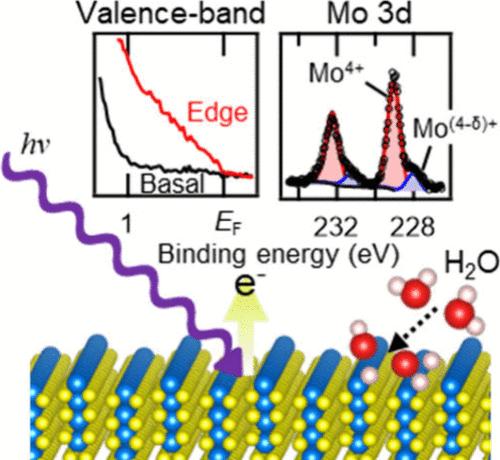激光切割二硫化钼表面边缘特异电子态和化学反应性的选择性观察
IF 3.2
3区 化学
Q2 CHEMISTRY, PHYSICAL
引用次数: 0
摘要
二硫化钼(MoS2)的边缘位点被认为是各种催化反应的活性位点。然而,选择性光谱研究边缘特定电子状态和表面反应一直具有挑战性,因为很难制备具有足够大和明确区域的边缘表面。在这项研究中,我们报告了一种利用超短激光脉冲切割大块晶体来制造MoS2边缘表面的新方法。这种方法可以在超高真空和常压(AP)条件下通过微观x射线光电子能谱(XPS)对边缘表面进行选择性光谱表征。价带光电子能谱仅在边缘表面显示费米能级的态密度。范德华密度泛函理论计算表明,锯齿状结构的边缘表面表现出金属性质,与硫缺陷无关。此外,边缘表面的Mo三维XPS光谱显示了与配位不饱和Mo原子相对应的组分。利用水蒸气下的AP-XPS,我们证明了水分子在室温下在边缘表面解离,其中不饱和的Mo原子作为水解离的活性位点。目前的边缘制备方法为研究范德华层状材料边缘表面的内在物理和化学性质提供了一个通用的平台。本文章由计算机程序翻译,如有差异,请以英文原文为准。

Selective Observation of Edge-Specific Electronic States and Chemical Reactivity of Laser-Cut MoS2 Surfaces
The edge sites of molybdenum disulfide (MoS2) are recognized as active sites for various catalytic reactions. However, selective spectroscopic investigation of edge-specific electronic states and surface reactions has been challenging due to the difficulty in preparing edge surfaces with sufficiently large and well-defined areas. In this study, we report a novel method for fabricating MoS2 edge surfaces by the ultrashort laser pulse cutting of bulk crystals. This approach enables selective spectroscopic characterization of the edge surface via microscopic X-ray photoelectron spectroscopy (XPS) under ultrahigh-vacuum and ambient-pressure (AP) conditions. Valence band photoelectron spectra show a density of states at the Fermi level only on the edge surface. van der Waals density functional theory calculations indicate that the zigzag-structured edge surfaces exhibit metallic properties regardless of sulfur defects. Moreover, the Mo 3d XPS spectra of the edge surface reveal components corresponding to coordinatively unsaturated Mo atoms. Using AP-XPS under water vapor, we demonstrate that water molecules dissociate on the edge surface at room temperature, where the unsaturated Mo atoms serve as the active sites for water dissociation. The present edge preparation method offers a versatile platform for studying the intrinsic physical and chemical properties of edge surfaces of van der Waals-layered materials.
求助全文
通过发布文献求助,成功后即可免费获取论文全文。
去求助
来源期刊

The Journal of Physical Chemistry C
化学-材料科学:综合
CiteScore
6.50
自引率
8.10%
发文量
2047
审稿时长
1.8 months
期刊介绍:
The Journal of Physical Chemistry A/B/C is devoted to reporting new and original experimental and theoretical basic research of interest to physical chemists, biophysical chemists, and chemical physicists.
 求助内容:
求助内容: 应助结果提醒方式:
应助结果提醒方式:


